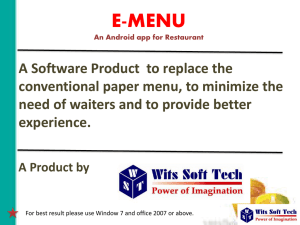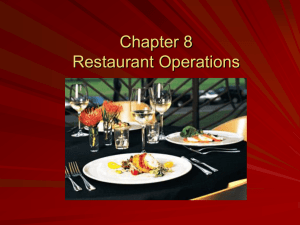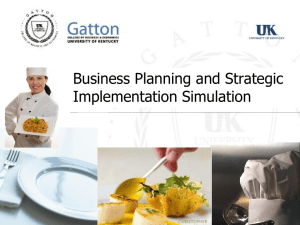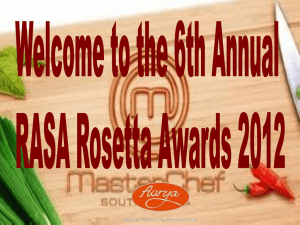Chapter 3 : Front Of The House Functions
advertisement
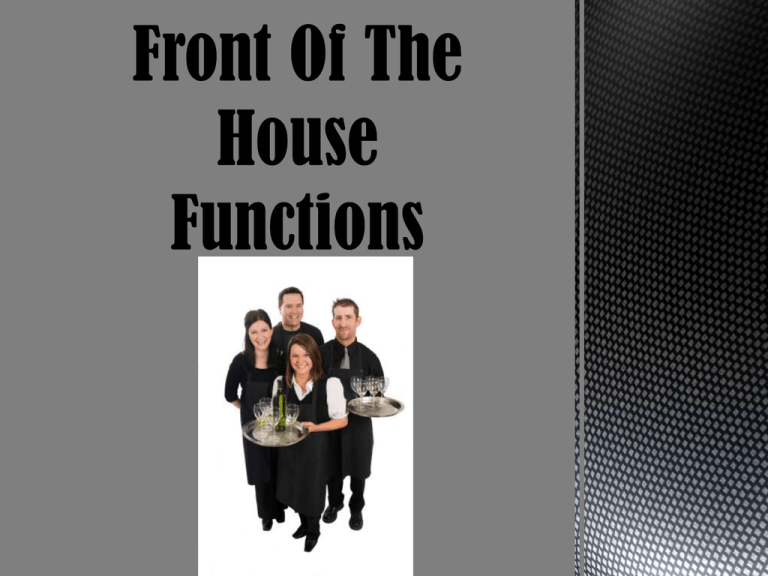
General Manager Front-of-the-House Seating Reservation Walk-ins Open seating Booking a reservation Overbooking Residence time Call-ahead seating Point-of-Sales System (POS) Culinary Pass-through The general manager (GM) is responsible for the overall operation of the restaurant Often, the owner of the restaurant is the general manager They are accountable for: o The entire restaurant operation o Front-of-the-house employees o Back-of-the-house employees o Supervise the other managers in the restaurant If the restaurant is apart of a corporate chain, the GM will be responsible for communications with the corporate headquarters Front-of-the-house refers to the area in a hospitality business that guests usually see In a restaurant, the front-of-thehouse usually includes: o Lobby or entrance o Hostess/ Host stand o Dining Room Front-of-the-house employees work directly with guest The front-of-the-house is responsible for the following six functions: o Seating guest o Selling food o Transmitting orders to the kitchen o Serving customers o Bussing tables o Obtaining payment form customers Seating is the process of finding seats for customers in a restaurant When customers enter a restaurant, they are seated by a host or hostess Customers should be seated as soon as they enter the restaurant Customers should be seated so that they will be served in the most efficient way A specific server is responsible for the tables in his or her station The host or hostess must evenly distribute the guests so that one station is not filled while another is empty Many restaurants have a computerized table management system If there are no tables available when the guests arrive, the hostess will give them a pager The customers will be paged when the restaurant has a table available to sit them at A reservation is a promise to hold something for a customer until the customer needs it In the restaurant industry, a reservation is a promise to have a table available for them Customers call ahead to reserve a table for a specific number of people for a particular date and time Walk-ins are customers who arrive at a restaurant but have not made a reservation These customers walk in the door and expect to be seated Open seating is when a restaurant will not accept reservations Customers are seated on a first come, first served basis The process of taking a reservation is called booking a reservation Reservations have advantages and disadvantages The main advantages include: o Tables are ready when the customer arrives o The restaurant will have an accurate account of the people to expect The main disadvantages include: o Guest may not show up for the reservation o The restaurant will lose money To avoid losing money when guests do not show up, some restaurants make more reservations than there are tables, this is called overbooking Residence time is the time that it takes a party to eat a meal, pay the bill, and leave the restaurant 90 minutes are usually needed for a party of four people to eat a complete meal that includes appetizers, beverages, the main course, and dessert Call-ahead seating is a fairly new seating method It is also called priority seating Call-ahead seating is when a customer calls the restaurant and have their names added to the waiting list o It does not guarantee the guest will have a table o It guarantees them a place in line The sales function occurs when the server takes the customer’s food order Servers use a process called suggestive selling Suggestive selling is recommending menu items that the customer may like Suggestive selling also increases sales for the restaurant and usually increases tips for the server Ways restaurants use suggestive selling: o Include wineglasses in the place setting o Sitting wine on the table o Offering additional items to an entrée o Offering dessert o Offering an after dinner drink A critical part of the restaurant business is getting the customers’ orders to the kitchen, then getting the correct orders back to the customers This process can be broken into five steps; 1. 2. 3. 4. 5. Taking the order Transmitting the order Preparing the order Checking the order Retrieving the order The server takes the orders from the guest Each table in the restaurant has a number At each table, the guest have a number Each restaurant has their own way of filling out checks for the guest The server must ensure that each order is recorded accurately Taking Orders 2 3 2 1 4 1 Entrance 3 4 Many restaurants use computers to improve the process of taking orders and transmitting them to the kitchen This computerized system is called a point-of-sales system A point-of-sales system (POS) is a computerized system for recording an order at the place where the order is taken Once the orders are accurately recorded, they must be transmitted to the kitchen There are two basic methods of transmission: o Computerized o Non-computerized In the non-computerized method, the server goes to the kitchen, places the order on a spindle, cook prepares the order In a computerized system, there is at least one printer in the kitchen. The orders are entered and sent to the proper printer The POS also improves ordering and transmission accuracy It will calculate and print out all the checks Other capabilities of the system include: oTrack the number of menu items sold oAlert servers of items that have sold out oKeeping track of inventory oCredit/debit card processing oEmployee time clock oEmployee schedules oPayroll oAccounting oFrequent diner loyalty programs oSales reports Once the orders are in the kitchen, the culinary staff takes over Culinary means related to kitchens and cooking The culinary staff consists of: o Chefs o Cooks o And other staff involved in preparing food While the main course is being prepared, the server can serve appetizers, soups, and salads Timing of food preparation is a critical skill in the restaurant business All guest of the same party should be served their main courses at the same time However, different courses take different amounts of time to prepare In many restaurant a team member called an expediter will organize the timing of the food After an order is done, but before it is packed up and served, it should be checked for accuracy and appearance The order should first be checked against the original order, either on the POS or the guest check The portion sizes must be correct, and the food must be properly cooked and arranged on the plate Food should be served as close to the time that it is finished cooking as possible Most restaurants will have a special area equipped with heat lamps to keep the food hot until served, this area is called the pass-through or the window Restaurants have various ways of alerting the staff that the food is ready Neon Number Board POS Alert at Computer Terminal Wireless Paging System Serving food and beverages is a major function of the frontof-the-house Regardless of style of service, quality service is the primary responsibility of the front-of-the-house staff Quality service takes place when guests in a restaurant never have to ask for anything Guest often do not realize that they have received excellent service until after they have left the restaurant Bussing is: Setting the place settings on the table Clearing the dirty dishes from the table Assisting the servers whenever needed After dessert and additional beverages are served, the check should be given to the customer If the server cannot determine who the host of the party is, the check should be placed face down in the center of the table Actual handling of payment is done in several ways: Customers take payment to a cashier Server takes payment Many restaurants only accept cash Others will accept credit and debit cards Restaurants within hotels will often allow hotel guests to charge restaurant bills to the room Front-of-the House Functions

